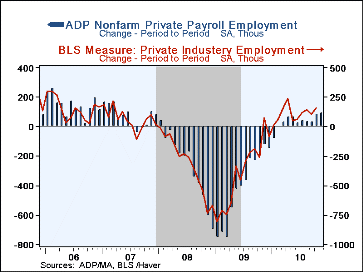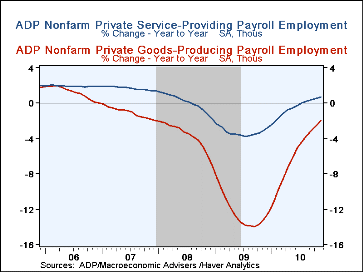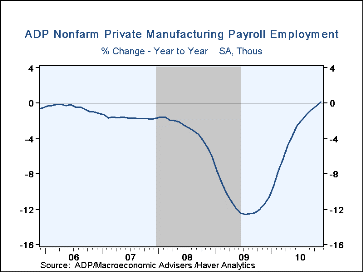 Global| Dec 01 2010
Global| Dec 01 2010ADP Report Indicates Firmest Job Growth Since 2007
by:Tom Moeller
|in:Economy in Brief
Summary
In its latest National Employment Report, the payroll processor, Automatic Data Processing (ADP), indicated that the level of private nonfarm payrolls rose 93,000 m/m during November. Upward revisions to earlier monthly figures show [...]
 In its latest National Employment Report, the payroll processor, Automatic
Data Processing (ADP), indicated that the level of private nonfarm payrolls rose
93,000 m/m during November. Upward revisions to earlier monthly figures show
modest positive growth during the last twelve months versus the previous
indication of a slight decline. The latest gain exceeded Consensus expectations
for a 58,000 increase.
In its latest National Employment Report, the payroll processor, Automatic
Data Processing (ADP), indicated that the level of private nonfarm payrolls rose
93,000 m/m during November. Upward revisions to earlier monthly figures show
modest positive growth during the last twelve months versus the previous
indication of a slight decline. The latest gain exceeded Consensus expectations
for a 58,000 increase.
The U.S. Bureau of Labor Statistics will report November payroll employment on Friday. Economists expect a 142,000 worker increase in jobs. For comparison, the October increase of 82,000 in ADP's measure of private nonfarm payrolls was accompanied by a 159,000 rise in the BLS measure of private sector jobs. According to ADP and Macro-Advisers, the correlation between the monthly percentage change in the ADP estimate and that in the BLS data is 0.90. ADP compiled the estimate from its database of individual companies' payroll information. Macroeconomic Advisers, LLC, the St. Louis economic consulting firm, developed the methodology for transforming the raw data into an economic indicator.
For the first month since early-2007, goods producing employment rose. The modest 14,000 gain lessened the y/y decline to 2.0%. At their worst, goods producing employment fell 334,000 during February of last year. In the manufacturing sector alone payrolls also rose 16,000 (0.1% y/y). Goods producing small payrolls rose 5,000 (-3.3% y/y) while medium-sized payrolls rose 13,000 (-0.8% y/y). Large-sized payrolls slipped another 4,000 (-2.2% y/y). Construction employment slipped 3,000. The greatest monthly drop of 120,000 was logged during March of 2009. Financial activities jobs were unchanged.
ADP reported that private service-producing industry employment rose 79,000 for the tenth consecutive monthly rise. Small-sized payrolls grew 49,000 m/m (0.8% y/y) while medium-sized payrolls rose 24,000 (0.7% y/y). Large service-producing payrolls inched up 6,000 (0.3% y/y).
The ADP National Employment Report data is maintained in Haver's USECON database; historical figures date back to December 2000. The figures in this report cover only private sector jobs and exclude employment in the public sector. The ADP methodology is explained here.
| ADP National Employment Report | Nov. | Oct. | Sept. | Y/Y | 2009 | 2008 | 2007 |
|---|---|---|---|---|---|---|---|
| Nonfarm Private Payroll Employment (m/m Chg., 000s) | 93 | 82 | 29 | 0.2% | -4.9% | -0.7% | 1.1% |
| Small Payroll (1-49) | 54 | 40 | 21 | 0.2 | -4.1 | -0.1 | 1.8 |
| Medium Payroll (50-499) | 37 | 38 | 11 | 0.4 | -5.7 | -0.9 | 1.0 |
| Large Payroll (>500) | 2 | 4 | -3 | -0.2 | -5.6 | -1.8 | -0.2 |
| Goods Producing | 14 | -22 | -27 | -2.0 | -12.3 | -3.7 | -1.1 |
| Manufacturing | 16 | -5 | -6 | 0.1 | -11.1 | -3.0 | -1.7 |
| Service Producing | 79 | 104 | 56 | 0.7 | -3.3 | 0.0 | 1.7 |
Tom Moeller
AuthorMore in Author Profile »Prior to joining Haver Analytics in 2000, Mr. Moeller worked as the Economist at Chancellor Capital Management from 1985 to 1999. There, he developed comprehensive economic forecasts and interpreted economic data for equity and fixed income portfolio managers. Also at Chancellor, Mr. Moeller worked as an equity analyst and was responsible for researching and rating companies in the economically sensitive automobile and housing industries for investment in Chancellor’s equity portfolio. Prior to joining Chancellor, Mr. Moeller was an Economist at Citibank from 1979 to 1984. He also analyzed pricing behavior in the metals industry for the Council on Wage and Price Stability in Washington, D.C. In 1999, Mr. Moeller received the award for most accurate forecast from the Forecasters' Club of New York. From 1990 to 1992 he was President of the New York Association for Business Economists. Mr. Moeller earned an M.B.A. in Finance from Fordham University, where he graduated in 1987. He holds a Bachelor of Arts in Economics from George Washington University.








